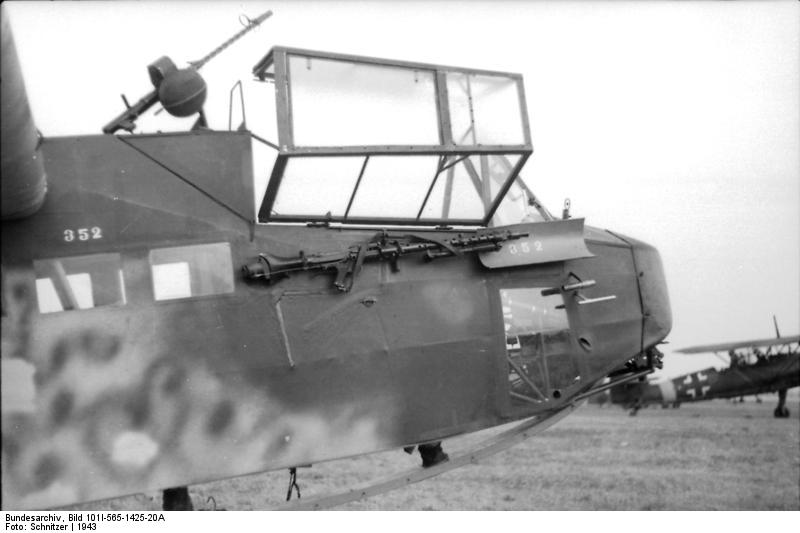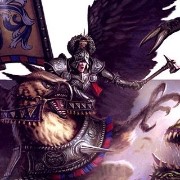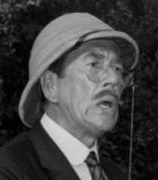|
Mr Enderby posted:Soldiers carried looms, and would weave the tents around themselves. everybody in pre-modern history was a caterpillar
|
|
|
|

|
| # ? Jun 10, 2024 13:30 |
|
question: how many wars had significant river battles? as an american i hear about the riverboat fighting during the civil war but idk if other wars had similar actions
|
|
|
|
Ainsley McTree posted:everybody in pre-modern history was a caterpillar And here, the musketeer will wrap himself in a cocoon of looted silk and looted wool for the winter. Come the spring, he will emerge as a beautiful pikeman, taking parts of his cocoon in order to become more attractive to other mercenary companies. What marvelous creatures. E: StashAugustine posted:question: how many wars had significant river battles? as an american i hear about the riverboat fighting during the civil war but idk if other wars had similar actions
|
|
|
|
OwlFancier posted:Yeah as far as I know the only method of producing steel before the advent of the blast furnace was blooming it which is... sort of you build a one shot furnace and fire it, then knock it apart and take the molten lump of steel and a bunch of poo poo out of the middle, then whack the hell out of it to get the good stuff. You can do it in a more permanent structure too but you still get a big lump of stuff out at the end which you have to then work with hammers. How is iron ore 'bad'? I genuinely don't know, I'd think iron is iron is iron - after all it is a basic element. Is it just low concentrations in the rock, or...?
|
|
|
MANime in the sheets posted:How is iron ore 'bad'? I genuinely don't know, I'd think iron is iron is iron - after all it is a basic element. Is it just low concentrations in the rock, or...? A combination of iron concentration in the ore, a relative lack of desirable impurities and the presence of undesirable impurities.
|
|
|
|
|
Don Gato posted:And here, the musketeer will wrap himself in a cocoon of looted silk and looted wool for the winter. Come the spring, he will emerge as a beautiful pikeman, taking parts of his cocoon in order to become more attractive to other mercenary companies. What marvelous creatures. My experience playing Dynasty Warriors confirms this. drat trying to figure out how to light the fire at Chibi
|
|
|
|
StashAugustine posted:question: how many wars had significant river battles? as an american i hear about the riverboat fighting during the civil war but idk if other wars had similar actions Rivers are always important barriers but I assume you mean river ships right? The War of the Triple Alliance had a bunch on the plate river, Yermaks expeditions fought from boats on occasion.
|
|
|
dublish posted:I don't know how you can think it took people in the middle ages hours to get dressed. It's been conclusively proven that most people went totally naked, and couldn't go shopping in the next town without getting hopelessly lost. Not to mention the complexity of avoiding the roving gangs of cannibal peasants in each village!
|
|
|
|
|
what did people who were sewn into their clothes do when they needed to pee or poop
|
|
|
Pornographic Memory posted:what did people who were sewn into their clothes do when they needed to pee or poop Panic.
|
|
|
|
|
Pornographic Memory posted:what did people who were sewn into their clothes do when they needed to pee or poop It wasn't covered in history class so it is unknown and also unknowable.
|
|
|
|
Pornographic Memory posted:what did people who were sewn into their clothes do when they needed to pee or poop or gently caress
|
|
|
|
SKY BOXES: Air Transports in the Second World War 1. Ju 52 2. German Gliders  Gliders are somewhat like tank killers in World War 2: while they were useful in that context, the march of technology gave them a short military service life. That said, they were useful in World War 2 sky haulin' in two ways: first, as a innovative way to expand air transport capabilities cheaply and easily. Depending on the glider, a tow aircraft could now haul cargo to a destination, which allowed even combat types to shoulder freight loads. Second, as a method for offensive operations. Like paratroopers, the glider promised a new mobile way to plant troops at strategic locations. In World War 2, this broke down into two further options: a especially sneaky way to land commandos, and another method to get more troops involved in a invasion's first wave. The Germans, with their problems making new powered transport aircraft, would be major users of gliders. This was also something of a cultural thing. With the Treaty of Versailles banning many types of flying, Germany got around that with the popularizing of glider clubs as a recreational sport. In addition to training lots of pilots who would end up in the Luftwaffe, it also allowed many later aeronautical engineers to cut their teeth in engineering and design. It's an air force, at a grass-root level! The glider organization Rhön-Rossitten Gesellschaft (RRG) was Nazified when the Nazis came to power, and changed the name to Deutsche Forschungsanstalt für Segelflug (German Research Institute for Sailplane Flight). DFS would design the first Nazi War Glider. The cost of Gliders was fairly simple: they were built to be disposable, and frequently had all the problems of cargo flying, but with the terrifying caveat " you only get one shot at several points; if you screw up, you and everyone aboard dies." Once a glider was released from a tow, it was committed to landing, and the ideal landing speed just above the stall speed (fatal). Once on the ground, friction would stop the aircraft, but if you went fast into a object above a certain degree of solidity, this was also fatal, at least to the pilot. Bulky cargo offered its own additional risks. Shifting cargo can be spectacularly fatal even to modern aircraft; on a glider it was naturally fatal, though there was the additional risk of a glider smashing into the ground/something else too hard and breaking the securing straps of the cargo, which would squish anything forward of it. (Fatal.) Towing had its own risks, as naturally command was all "why tow only one glider when you can tow three" and there was all sorts of additional complications (the tow-plane flying too slowly or too fast) that in something built to be disposable could easily be fatal to the glider crew and passengers. Once you were on the ground of course, it was all ice cream and lollipops, being a small group of men in the chaos of a live combat zone. The pilots were now infantry along with the rest of the squad.  DFS 230 - The one you'd pick to be in if you had a choice First flew: 1936 Empty weight: 860 kg (1,896 lb) Max takeoff weight: 2,100 kg (4,630 lb) Glide ratio: 18 to 1 (IE 18 m for every 1 m lost) Cruising speed: 180 km/h (112 mph) Payload: 9 equipped troops plus 270 kg The prewar German glider is a standout in an important respect: it had an small capacity for stuff/people and a expanded capability for flying. Carrying just 9 fully equipped troops, the DFS 230 was the most produced glider, having some 2,230 made by Gothaer Waggonfabrik. It had a tubular-steel frame construction for the fuselage with plywood wings, covered in doped fabric. For takeoffs it rolled on a dolly that jettisoned after takeoff; landing was done with skids. Landing could be assisted by a drogue chute or (in the case of Mussolini's rescue) retro-rockets. As the DFS 230 was light for a combat glider anyway, it was already very good at stopping. The DFS 230 are most famous for two actions: the capture of a fort Eban Emael in Belgium in May 1940, and involvement in the invasion of Crete in May 1941. As far as German air infantry went, glider troops had two really important advantages: they arrived together, and could travel fully equipped. (Despite paratroops being so much of a part of German successes early in the war, they labored under some handicaps. They could not steer their parachutes, and had all their heavier equipment come in canisters on chutes.) The main drawback of the DFS 230 was its small size: It took 12 to deliver 120 men of a company, and 50 to deliver a battalion. This search for more capacity would inspire the other two major gliders the Germans used. In addition to assault, the DFS 230 was used to move cargo, and in a pretty brilliant improvisation, DFS 230s were sometimes outfitted as forward mechanic's vans, towed to forward airfields by the aircraft they would service, and towed back again when it was time to move.  The DFS 230 would also be the only German glider to be used in assaults. Crete as it turns out would be the last major air infantry operation the Germans undertook. Apparently combat operations after this were restricted to commando raids, which the DFS 230 was ideal for.  Gotha 242 - Good design, nice effort First flew: 1941 Empty weight: 7,055 lb (3,200 kg) Max takeoff weight: 15,653 lb (7,100 kg) Glide ratio: 18 to 1 (IE 18 m for every 1 m lost) Cruising speed: 180 km/h (112 mph) Payload: 23 equipped troops or a 3.7cm AT gun or a 7.5 cm anti-infantry gun or a Kübelwagen or 3800 kg The Go 242 was a logical followup to the DFS 230, in that it was a larger glider that could carry more troops, supplies, or light guns or vehicles. Like the DFS 230 it had a steel tube fuselage, with plywood wings and tail, covered in doped fabric. 1,580 copies were made, with 130 being modified into the powered Go 244. The much larger mass of the Go 242 restricted its tow-plane options - they were typically the Ju 52 or the He 111. It initially went with the dolly being dropped after takeoff, but would later gain permanent landing gear, as the Go 242 would be reused whenever possible. It seems to have retained the DFS 230's impressive airworthiness, not only useful in avoiding death for pilots and passengers, but also likely helping the Go 242 avoid damage on landing.  The main oddity of the Go 242 is that it was never used in combat - it was used entirely as a transport glider in North Africa, the Eastern Front, the Balkans, and the eastern Mediterranean - possibly making it the second most important sky truck by numbers. As a cargo hauler, the Go 242 was used for what you'd expect: delivering supplies and re-enforcement to forward positions, resupplying cut off columns, and later evacuating troops. Like the DFS 230, it was also used as a mobile machine shop and sometimes as a mobile HQ for fighter/ground support formations operating in forward positions.  Me 321 - Three words: Glider. War. Elephants. First flew: 1941 Empty weight: 12,400 kg (27,300 lb) Max takeoff weight: 34,400 kg (75,800 lb) Glide ratio: Likely around 10 to 1 tow speed: 160 km/h on tow (100 mph) Payload: 130 equipped troops or sixty stretchers, or 20 metric tons (44,000 lbs) The thread is well familiar with the general craziness of operation Sea Lion. The Me 321 started as a result of Sea Lion, and it shows. The Luftwaffe decided that it support of Sea Lion it would need more, much heavier gliders, and gave Messerschmitt and Junkers two weeks to propose a glider that could haul anything up to a Mk. IV Panzer, or a 88mm gun and its prime mover. This was much of a kind of having barges tow other barges of horses through the English channel for about 30 hours, as aircraft, let alone gliders, were not hauling that sort of weight around. Naturally the two month deadline didn't allow the new glider to be constructed. The Me 321 first flew in February 1941, the Nazis had already given up on Sea lion, but decided that gliders would be the cheapest way to expand their air lift capacity.  The wingspan certainly was giant - it was 180 ft, larger than the later B-29. And it managed to hit it’s cargo targets of being able to carry a Panzer IV - the cargo compartment was so large the Me 321 could have fit a standard boxcar inside it, if there was a thing as the world’s lightest boxcar. The clamshell nose opened for easy interior access, and troops could use doors behind the glider’s wings. Big surprise, the Giant was not especially pleasant to fly, the sheer mass of the loaded glider making controls sluggish, just what you want in an aircraft that can’t abort a decent. The Me 321 had jettisonable landing gear in addition to the normal landing skids, but typically retained their gear as they were reused quite often. The first 100 (the A series glider) had one pilot, which apparently kind of sucked, as the control forces were very heavy. The B series gained two pilots, plus a mechanic, and gained an electrical assist for the controls. Total production for the glider was 198. A few of these would be converted to the motorized version, the Me 323. Deployed in May 1941, the Giant glider had one problem, and it was a fairly preposterous one: the difficulty of finding a tow aircraft. The first Me 321s were towed by the Ju 90 - and those were flight tests with a empty Me 321. As there was all of ten of those, a second solution was proposed: having three Bf 110s do the towing. Having three fighters fly close formation and tow a giant glider was obviously very dangerous, and after many accidents the He 111Z was made. Two He 111s were linked together at the wing and given an extra engine. This aircraft had the power the Me 321 needed in a tow vehicle. This wasn’t a great solution, though, as the Reich would build a total of 12 He 111Zs. This pinch in tow aircraft made it difficult to use the Me 321 in numbers, and would see the program move on to the more useful Me 323. Like the Go 242, takeoff assist rockets were often used to help get a heavily loaded glider airborne. These rockets would be jettisoned once used up, and would deploy parachutes, allowing them to be used again. The gliders were used extensively to transport supplies around the eastern front, and North Africa. Apparently quite a few Me 321s met their fate running supplies to North Africa, once the Allies began to constrict Axis supply lines across the Mediterranean. An He 111Z tows a Me 321 skyward.  He 111Z.  Go 242 sharkmouth. 
|
|
|
|
MANime in the sheets posted:or gently caress That's why everyone carried swords around all the time.
|
|
|
|
MANime in the sheets posted:or gently caress Medieval people grew from eggs
|
|
|
|

|
|
|
|
Fun fact - the DFS-230 carried a squad of paratroopers (Fallschirmjagers) who had an MG34. The MG34 was strapped to the exterior of the glider: There was a small opening on the side of the glider (zippered shut in this picture) that the man sitting behind the pilot could reach his arm through through to fire the machinegun. I doubt their fire was very accurate.
|
|
|
|
MANime in the sheets posted:How is iron ore 'bad'? I genuinely don't know, I'd think iron is iron is iron - after all it is a basic element. Is it just low concentrations in the rock, or...? Japan has a lot of iron sand, which is like, basically eroded rock with small iron concentrations, you need to smelt a lot of it to get any usable metal out. This is less of a problem in a blast furnace because it just means you end up with more slag, but with bloom production it means you have to hammer off all that slag and also build a really big furnace to fire all that ore. And it makes getting the good quality core more difficult too because it's harder to get a definite core when the ore is low richness.
|
|
|
|
StashAugustine posted:question: how many wars had significant river battles? as an american i hear about the riverboat fighting during the civil war but idk if other wars had similar actions Vietnam did, though a lot of that was fighting between the river and the shore.
|
|
|
|
What does iron sand look like? Is it the black sand you see every once and a while on beaches? Is it reddish showing a lot of oxide? Yeah I could google it but I figure someone on this thread knows more than the first few results I'd pull.
|
|
|
|
Nebakenezzer posted:Me 321 - Three words: Glider. War. Elephants. 
|
|
|
|
Everything the luftwaffe had besides fighters was an agonising mess, thats my opinion forever.109 and 190 production was so modernized and reasonably effective that production continued rising til 1945, but can anybody say that of the 30s airliner vintage bombers and transports? The worlds largest transports completely wasted in unsustainable and failed ressuply missions? God if anybody knows anything about multi engine aircraft developement in germany Id love to hear it, because as far as im concerned it all stopped in 1939 and everything after was totally fly-by-wire nonsense Seriously, ive heard a number of wehraboos blab about uralbombers, but i could not reasonably expect anything out of that project besides airborne lemons and maybe 20 of them besides that. Slim Jim Pickens fucked around with this message at 13:33 on Nov 17, 2017 |
|
|
|
Nebakenezzer posted:2. German Gliders Gotta say, their insignia game was on point. Still, though. Leave it to the Luftwaffe to design a glider to make up for their lack of big aircraft, only to then have to design a new big aircraft to actually tow it.
|
|
|
|
Slim Jim Pickens posted:Everything the luftwaffe had besides fighters was an agonising mess, thats my opinion forever.109 and 190 production was so modernized and reasonably effective that production continued rising til 1945, but can anybody say that of the 30s airliner vintage bombers and transports? The worlds largest transports completely wasted in unsustainable and failed ressuply missions? God if anybody knows anything about multi engine aircraft developement in germany Id love to hear it, because as far as im concerned it all stopped in 1939 and everything after was totally fly-by-wire nonsense The problem is that you're looking at production numbers and some failed missions/total losses as being indicative of the aircraft's design being terrible, which isn't always the case. The Go-242 or the Me-323 weren't lovely designs, they lacked production numbers and were slotted in desperate situations. The Airspeed Horsa and the Gotha Go-242 carry relatively the same amount but the German glider is smaller and can go faster. Its cherry picking a little, sure, but the fact of the matter is that German engine production (and development) was lacking, and strategic changes forced losses to a vital part of the airforce. The DC-3/C-47 is still in use today, which can't be said for the 109 or the 190... or the Spitfire or the P-51. As for multi-engine aircraft development, the Germans were fine with twin-engined machines, but tactical and strategic doctrine precluded the use of long-range bombers. Anyone within the Luftwaffe or Germany's armament program that saw the strategic bomber as a useful tool either died or lacked the necessary influence to change things. The He-177, lampooned often here and elsewhere, wasn't as disastrous a design as people make it out to be. Did it change the tide of war? Obviously not, but it was a "too little, too late" thing similar to the Me-262. You can build thousands of them if you want, but without fuel, experienced crew, or working airfields, a successful design won't do you much.
|
|
|
|
So what is keeping nazi multi-engine planes at such low production levels? Where were they loving up? I can accept the designs being sound, but it seems that production was at like, intewar pleasurecraft levels the entire time
|
|
|
|
Why build one design when you can build two at ten times the price?
|
|
|
|
StashAugustine posted:question: how many wars had significant river battles? as an american i hear about the riverboat fighting during the civil war but idk if other wars had similar actions Here you have a particularly hilarious example, if lakes count: https://www.youtube.com/watch?v=i5cp-QFzfxU
|
|
|
|
Slim Jim Pickens posted:So what is keeping nazi multi-engine planes at such low production levels? Where were they loving up? I can accept the designs being sound, but it seems that production was at like, intewar pleasurecraft levels the entire time Engine power and reliability was where they had the most issues, I'd say. The lack of production capacity to build large aircraft also meant that they tried to consolidate Strategic Bomber specs into a Medium Bomber airframe, which is how the He-177 came to be, but since they needed 2 engines to perform as well as 4, they came up with their goofy design to couple multiple engines. A lack of experience and other difficulties led to the numerous fires from these powerplants. Most, if not all, of their high-performance engines were abandoned. Few engines in the Third Reich could hit 2,000HP and above.
|
|
|
|
How much collaboration was there between the Nazis and the Japanese in WWII? Did they try and coordinate timings of attacks at all, or did they ultimately just do their own thing?
|
|
|
|
Jeez I wish wwii video games would stop portraying german tech like it was a juggernaut. What was the Double Wasp, like 1939??
|
|
|
|
Fangz posted:How much collaboration was there between the Nazis and the Japanese in WWII? Did they try and coordinate timings of attacks at all, or did they ultimately just do their own thing? The only collaboration was tech, for the most part, via U-boat missions. I don't believe there was any coordination regarding attacks or strategic goals.
|
|
|
|
Slim Jim Pickens posted:Everything the luftwaffe had besides fighters was an agonising mess, thats my opinion forever.109 and 190 production was so modernized and reasonably effective that production continued rising til 1945, but can anybody say that of the 30s airliner vintage bombers and transports? The worlds largest transports completely wasted in unsustainable and failed ressuply missions? God if anybody knows anything about multi engine aircraft developement in germany Id love to hear it, because as far as im concerned it all stopped in 1939 and everything after was totally fly-by-wire nonsense They also excelled at heavy fighters and medium bombers...the Ju-88 and Bf-110 (and their descendants) were at least arguably the best of their type.
|
|
|
|
Cessna posted:There was a small opening on the side of the glider (zippered shut in this picture) that the man sitting behind the pilot could reach his arm through through to fire the machinegun. I doubt their fire was very accurate. Not to mention that a strafing run with a glider is... Ill-advised. You're going to end up not far from the people you just strafed, and they're going to be angry about it.
|
|
|
|
Slim Jim Pickens posted:Jeez I wish wwii video games would stop portraying german tech like it was a juggernaut. What was the Double Wasp, like 1939?? This applies to just about every nation. Certain nations excelled at certain things, but, in terms of aircraft engines, the engine alone will not guarantee the success of a design. Several late-war Japanese designs were highly regarded, despite the lack of comparable horsepower between them and US aircraft.
|
|
|
|
bewbies posted:They also excelled at heavy fighters and medium bombers...the Ju-88 and Bf-110 (and their descendants) were at least arguably the best of their type. The Bf-110, not so much. I'd say the Mosquito certainly outshines it, and the Potez 630 design had potential. MrYenko posted:Not to mention that a strafing run with a glider is... Ill-advised. You're going to end up not far from the people you just strafed, and they're going to be angry about it. Well, you just use it to suppress whatever you're flying towards. Give yourself enough time to jump out of the glider and properly set up firing positions type of thing.
|
|
|
|
Look i'm coming off a Cod:wwii where loving stukas are a plot element in 1944 France soI'm just peeved as heck in general and have no outlet besides this forum
|
|
|
|
Slim Jim Pickens posted:Look i'm coming off a Cod:wwii where loving stukas are a plot element in 1944 France soI'm just peeved as heck in general and have no outlet besides this forum Yeah... Don't worry though, the MG-34 is side-ejecting in that game if I recall correctly!
|
|
|
|
13th KRRC War Diary, 17th Nov 1917 posted:TOUR IN THE FRONT LINE Other battalions in the 111th Brigade 10th battalion Royal Fusiliers 13th battalion Royal Fusiliers 13th battalion Rifle Brigade Appended map in the war diary -  Another version of the original map made by pasting together trench maps from 1916-1917 with the front line shown  Annotated modern map which shows the front line and where the battalion moved from -  An aerial photo from the area at roughly the right time showing the state of the terrain. On the trench map above that shows the front line, the area the photo covers is shown be a white square in the map square with I in it. The arrowed location in the photo is shown by a green X on the map.  How to read trench map co-ordinates I've not managed to identify where "the Clusters" are as yet, but probably in the area of Klein Zillebeke. Hill 60. Yes, that Hill 60. The location of SPOIL BANK is shown on the modern map. James Noel Evans-Jackson Awarded Military Cross 14/08/1017, and a Bar on 08/03/1919. Then another Bar on 04/10/1919. Final rank of "Temporary Major". Citation for the second Bar : "For marked gallantry and skilful leadership during the attack on Neuville on 23rd Oct, 1918. He was leading the leading wave, and when the company was held up about 300 yards short of the objective he personally took forward two Lewis gun sections, and by skilful manoeuvring outflanked the enemy, who surrendered with ten machine guns." Further spoiler - this is the attack my grandfather was wounded in. Capt. R.E. Stavert Date of death 25/08/1918
|
|
|
|
Slim Jim Pickens posted:Jeez I wish wwii video games would stop portraying german tech like it was a juggernaut. What was the Double Wasp, like 1939?? Men of War handled it well. I think you get one Tiger in the German campaign, and you have to constantly babysit it with your smaller and cheaper tanks so it doesn't get its tracks knocked off and pelted to death by grenades. Of course, in the British campaign you have to withstand hordes of Tigers coming at you in the final mission. At least you have a battery of 17- and 25- pounders to help out.
|
|
|
|

|
| # ? Jun 10, 2024 13:30 |
|
Clarence posted:
Dude had a good run
|
|
|

































